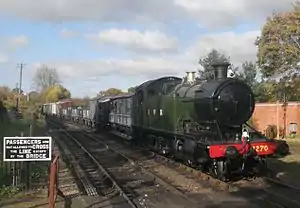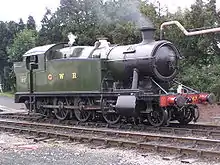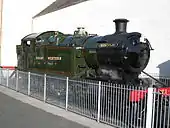GWR 4200 Class
The Great Western Railway (GWR) 4200 Class is a class of 2-8-0T steam locomotives.
| GWR 4200 Class | |||||||||||||||||||||||
|---|---|---|---|---|---|---|---|---|---|---|---|---|---|---|---|---|---|---|---|---|---|---|---|
 GWR 2-8-0T Class 4200 No. 4270 hauls a goods train at Arley on the Severn Valley Railway | |||||||||||||||||||||||
| |||||||||||||||||||||||
| |||||||||||||||||||||||
| |||||||||||||||||||||||
| |||||||||||||||||||||||
History
Development
After the GWR took over operations and then absorbed the various South Wales based railways from the late 1800s, operational practice on most was defined by moving heavy coal trains on sharp, steep and undulating tracks. Thus many of these railways - especially the dominant Taff Vale Railway - specified and used an 0-6-2T, which gave maximum tractive effort whilst riding well on the undulating track.[1]
With coal trains increasing in size and scale, the GWR needed to develop a more powerful locomotive to meet these requirements, on what were relatively short haul routes. Thus in 1906, Chief Engineer G.J. Churchward took the basic design of his GWR 2800 Class, and adapted it. After proposing a 2-8-2T design, Churchward developed the UK's first 2-8-0 Tank engine, through concerns that the longer frames required for a 2-8-2T would restrict operation in the South Wales Valleys.[1][2]
Churchward upgraded the power of the design, modifying the frames to hold a GWR standard No.4 boiler over the 2800 Class standard No.1. The flanges of the second and third driving wheels were made thinner, and the coupling rods between the third and fourth sets of driving wheels used spherical joints, all to create side play and hence flexibility in operations. The prototype No.4201 was out shipped from Swindon Works in 1910 under Lot No.142, with a straight back bunker capable of containing three tonnes of coal. In 14 months of testing, it easily proved itself capable of negotiating curves down to 2 chains (130 ft; 40 m) in radius.[1][2]
Operations
Put into production in 1912 under Lot No.187, the first locomotives were Nos. 4202 - 4221, which had both top feed boilers and curved upper bodies to their coal bunkers to provide 3.5 tonnes of coal carrying capacity.[2] Working 1000+ ton coal trains through the South Wales Valleys, from coal mines to ports, the large boilers and restricted loading gauge resulted in narrow side tanks. Although passing numerous water stops along their routes, because of the class’s heavy water consumption and limited tank capacity, they were nicknamed "Water Carts". 105 4200s were built between 1910 and 1923.[1][2]
Modifications
In 1919, from Lot No.213 (4262 - 4285) onwards, the coal bunker was built six inches taller, increasing coal capacity to 4 tons.[1][2] In 1921, having also run out of allocation numbers, the class received its first major upgrade. Increasing cylinder diameter from 18.5 inches (470 mm) to 19 inches (480 mm) increased tractive effort to 33,170 pounds, thus creating the distinctive later GWR 5205 Class.[1][2]
The last batch of the 5205 Class produced pre-World War II were lot No.266 of 1930, producing No's 5275-5294. However, due to the Stock Market Crash of 1929, and a resultant down turn in coal exports to Europe, a number of the 4200 Class having been returned to Swindon for overhaul, had in fact been stored there. To increase their operational ability across the wider GWR network, Chief Engineer Charles Collett took the board-agreed decision to alter this batch in production to 2-8-2T by adding a bolt-on 4 feet (1.22 m) extension to the frames to accommodate a pair of rear trailing wheels, which took the coal capacity up to 6 tons and water tanks to 2500 gallons. This created the GWR 7200 Class 2-8-2T.[3] Due to demands from the Operational Department for more of the 7200 Class, from the stored 4200 Class locomotives at Swindon, fourteen were rebuilt between 1937 and 1939 as 7200 Class locomotives.[1][2][3] Although operationally banned from certain goods yards, most 7200's found work across the GWR system, mostly deployed on iron ore and stone trains from Banbury.[4]
In later years many of the remaining 4200s were upgraded to 5205 specification with outside steam pipes, larger cylinders and in some cases curved frames at the front end.[1][2]
Withdrawal
All but one, No.4224, passed in the ownership of British Railways on Nationalisation.[1][2] The first engine withdrawn was number 4224 in February 1959 and by the end of steam on the former GWR system, 18 were still working at the start of 1965, the last withdrawn being No.4268 in August 1965.[5]
Preservation
Five have been preserved, with all rescued from Woodham Brothers scrapyard in Barry, Vale of Glamorgan, South Wales. Three of the five surviving members of the 4200 have run in preservation.
| Number | Year Built | Withdrawn | Location | Status | Photograph | Notes |
|---|---|---|---|---|---|---|
| 4247 | Mar 1916 | Apr 1964 | Bodmin and Wenford Railway | Operational, Boiler Ticket Expires: 2021[6] |  |
In 5205 specification, outside steampipes but straight footplate. Left Barry in April 1985. It is the oldest survivor of its class in preservation marking its centenary in Mar 2016. |
| 4248 | Apr 1916 | May 1963 | Swindon Steam Railway Museum | Static museum exhibit | .jpg.webp) |
In 5205 specification. Left Barry in May 1986. Conserved rather than restored, on show dismantled as if it were "in the Swindon Works." |
| 4253 | Mar 1917 | Apr 1963 | Kent and East Sussex Railway | Under restoration | .jpg.webp) |
Has 5275 style footplate with a raised section over the cylinders. Left Barry in August 1987, stored at Pontypool and Blaenavon Railway until 2011, then sold to group from K&ESR.[7] |
| 4270 | Dec 1919 | Sept 1962 | Gloucestershire Warwickshire Railway | Operational, Boiler Ticket Expires: 2024 |  |
Retains original inside steam pipes. Left Barry in July 1985, owned by Jeremy Hosking.[8] |
| 4277 Hercules | Apr 1920 | Jun 1964 | Dartmouth Steam Railway | Under overhaul. |  |
Retains original inside steam pipes. Left Barry in June 1986.[9] |
In the case of 4277 its name is historically inaccurate, i.e. it being applied in preservation.
Models
In 2012, Hornby released models of the 4200 class in both original GWR green and BR black.[10]
See also
| Wikimedia Commons has media related to GWR 4200 Class. |
References
- ABC of British Railways Locomotives, part 1. Ian Allan. Winter 1957–1958. pp. 20–21.
- le Fleming, H.M. (February 1962). White, D.E. (ed.). The Locomotives of the Great Western Railway, part nine: Standard Two-Cylinder Classes. RCTS. p. J38-J42.
- "7202 - 2-8-2T". Didcot Railway Centre.
- Quainton Railway Society. "GWR 72XX Class 2-8-2T No. 7200". Buckinghamshire Railway Centre. Archived from the original on 12 August 2020.
- Daniel, John (14 July 2013). "4200 tank class introduction". The Great Western Archive.
- "GCR Locomotive:4247". Archived from the original on 3 December 2013. Retrieved 23 November 2013.
- "About 4253". Retrieved 23 November 2013.
- "GWR - Gloucestershire's mainline heritage railway - 4270 steams!". Archived from the original on 17 May 2014. Retrieved 15 May 2014.
- "Dartmouth Steam Railway & River Boat Company : Our Locomotives". Archived from the original on 2 December 2013. Retrieved 23 November 2013.
- "National Model Rail Database". National Model Rail. Archived from the original on 3 March 2016. Retrieved 13 September 2015.